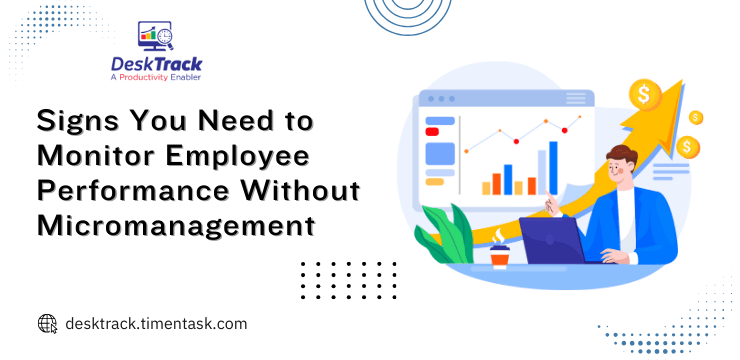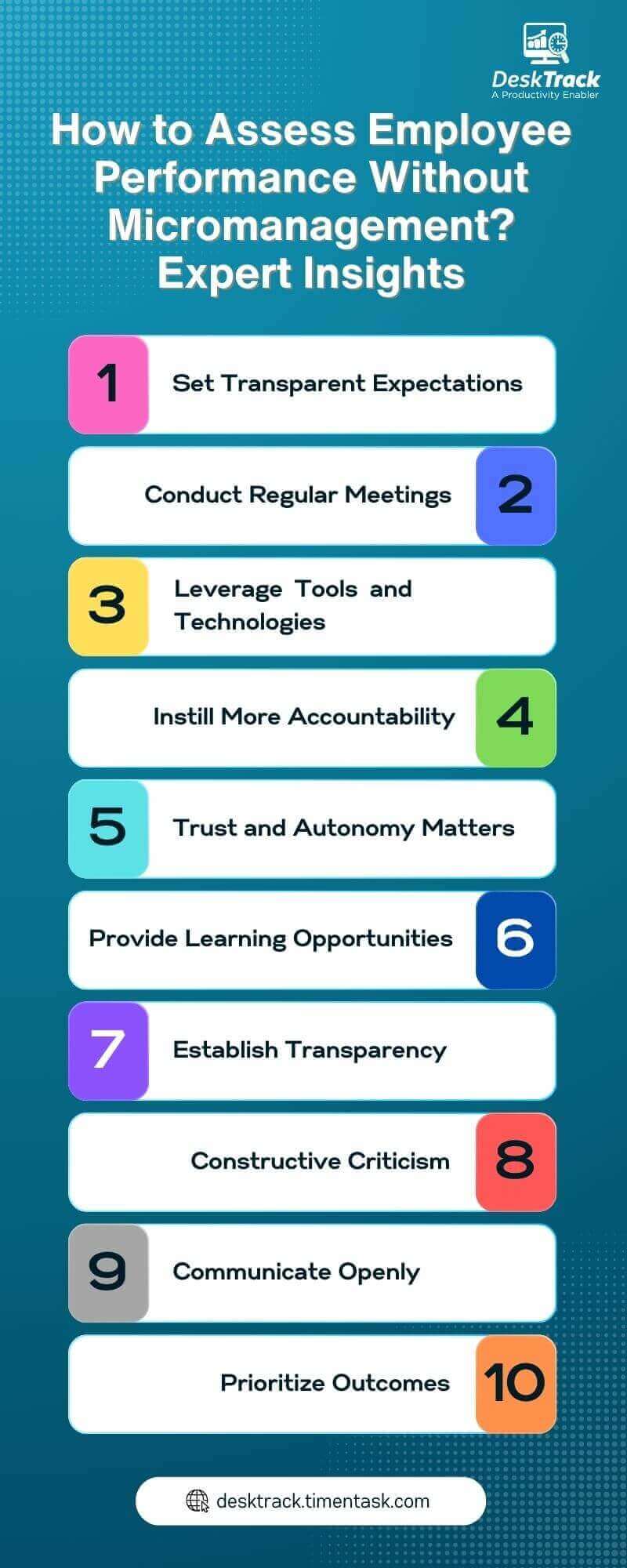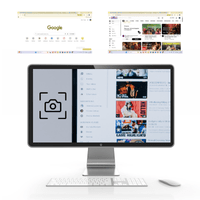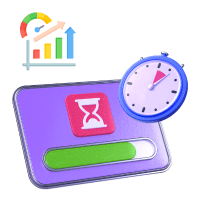
| Micromanagement indicates that you have no trust in your teams. Although you are not at complete fault, as it happens from the need for perfection, you are controlling everything. You might be unsure about your abilities. However, the worst part about micromanagement is that managers think that their way of doing things is the only correct way to cover their self-doubt. |
| Micromanagement | Detail-Oriented Management |
| Managers control every aspect of their employees’ tasks | Managers provide useful guidance |
Is it even possible to monitor employee performance without micromanagement? Asked a random bad manager. It was impossible and daunting for her to do. However, the reality is managers like these have no clue how they are harming their employees’ mental health.
We can call micromanagement in simple terms, too much management or monitoring employees while crossing certain boundaries. Did you know that a flip side to micromanagement is under-management? The latter is completely ignoring employee management to avoid conflicts or being accountable.
Both micromanagement and under-management are bad for productivity. That’s why we need to monitor employee performance without both as a priority.
So in this blog, we will overview micromanagement with signs indicating whether you are doing it and its negative consequences. Furthermore, we will also shortlist some expert tips to monitor employee performance without micromanagement for maximum productivity. With that being said, let’s get right into eliminating micromanagement in all its forms.
What is Micromanagement?
Before getting rid of something, it’s important to identify what it is and why it is bad for productivity. Overall, you need to know why employee monitoring without micromanagement is better. As we mentioned before, micromanagement is too much control over your employees. To identify whether you are micromanaging or not, you should check whether you are:
- Paying more than enough attention to small unconsequential details.
- Interfering with tasks your employees can handle themselves.
- Not giving freedom to your employees and making all decisions for your team.
- Constantly criticizing your employees to limit creativity and employee autonomy.
- Having a fear of losing control over your employees.
If all of the above is relatable to you, you need to learn how to monitor employee performance without micromanagement. Furthermore, the downside to micromanagement is that:
- You are a manager with unrealistic expectations.
- You lack strong leadership.
- It stops your team’s growth and creates a stressful work environment.
Read More 👉 Time Tracking Software Boost Business Efficiency
Signs You Need to Monitor Employee Performance Without Micromanagement

Micromanagement is anything but the best way of monitoring work performance. That’s why you need to replace it with better alternatives immediately. However, how will you identify whether you are micromanaging or not?
1. Excessive Oversight
It is important to monitor employee performance without micromanagement to get rid of excessive oversight. In simple terms, the first sign of micromanagement is overseeing everything in the work process. It’s almost as if you are standing behind your employees 24/7.
- For example, ordering your teams to approve every draft before the report creation moves to the next stage
2. No Delegation
If you are one of those who don’t think that anything can be trusted with others then you are maximizing your workload only. Instead, a better alternative is to track employee productivity without micromanagement.
- For example, scheduling a meeting yourself without asking your assistant to do it.
3. Focusing on Minor Details
Focusing on minor details of the project can make you entirely miss the final output. What it does is distract your team and stress them out. Instead, monitor employee performance without micromanagement and see their productivity skyrocket.
- To give you an instance, focusing on report font size rather than its content.
4. Constant Check-Ins
Managers who constantly check on their employees now and then, interrupting their work to ask for clarifications or updates are often disliked. Why wouldn’t they be? They are forcing their employees to feel pressured. The idea is that employee performance monitoring should not interrupt workflows and decrease productivity.
- For instance, scheduling multiple unexpected meetings in a day to discuss a project.
5. Discouraging Employees
“Who did you ask before sending that email?” Sounds familiar? That’s because it is. That was just one example of how micromanagers discourage their employees. You can also say one instance of how micromanagers lead their employees to a loop of self-doubt and self-embarrassment. Surprised by how harmful it is? There are 15 more reasons why you need to monitor employee performance without micromanagement.
- For example, the compulsion for your employees to take your permission even before making small business purchases.
6. Requesting Updates Unnecessarily
If you are requesting detailed and unnecessary reports on tasks that don’t even require close monitoring, then it indicates micromanagement. This again interrupts the workflow and lowers employee productivity. This often creates a tense atmosphere to get rid of which, employee monitoring without micromanagement is the only solution.
- For example, to demand hourly reports on small tasks including social media posts.
7. Redoing Work
If you want to lose your employees’ trust, then this is a sure-shot way to do it. We are pointing towards managers who minutely correct every mistake without involving their team. We never do it and always monitor employee performance without micromanagement.
- For example, changing every email draft format before sending them.
8. No Chain of Command
This one is as simple as it sounds. In other words, managers directly instruct employees without involving their team leads. However, they are unaware that it can create confusion and stall the project entirely. This is not the best way of monitoring work performance as it devalues team leaders as well.
- For instance, directly yelling at a junior developer to fix a bug.
9. Excessive Time Tracking
As per research, employees at high-trust organizations report 74% less stress, 106% more work energy, 50% higher productivity, 13% fewer sick leaves, 76% more engagement, and 29% more job satisfaction. However, micromanagers will never achieve these stats as they doubt the ability of their employees to effectively manage their time.
- For example, employees need to check in with a supervisor to report every hour of work activity.
10. Controlling Communication Channels
Micromanagers have to poke their nose in everything their employees do. Even in their communication channels. It is because they are insecure and thus instruct when and how teams will communicate, missing the whole point behind effective employee performance tracking.
- For example, making it mandatory for your employees to include you in CC on all project communications.
Read More 👉 Employee Productivity Tracking Software Needed in 2025
11. SOPs Over Everything Else
Another reason you need to monitor employee performance without micromanagement is to get better work outputs. However, micromanagers do the opposite of that. They instead focus more on the work procedures.
- For instance, every task requires a detailed checklist.
12. No Respect for Personal Boundaries
As we have mentioned in our previous blogs as well, your employees also have life outside your office hours. That’s why we strictly encourage employee monitoring without micromanagement. However, micromanagers will for example call their employees regarding work when they are enjoying a family picnic.
- Another instance, sending work emails outside of work hours and expecting immediate replies.
13. Hiding Information
Hiding information from your employees prevents them from making informed decisions and breaks their trust. We have no clue why some managers can’t monitor employee performance without micromanagement.
- For example, delaying sharing new budget information until a week into quarter no 4.
14. Public Criticism
Scolding your employees in front of everyone else diminishes their motivation to continue working for you. As a result, they will start working like robots, which will not be progressive as their mental health also becomes poor. Now you see how important it is to track employee productivity without micromanagement.
- For instance, criticizing an employee’s presentation in a team meeting and pointing out all the minor mistakes.
15. Ignoring Feedback
When you monitor employee performance without micromanagement, you listen and think about every minor feedback. However, micromanagers do the opposite of that which hinders the trust and professional bond.
- For example, when you dismiss every suggestion regarding project management.
16. Unrealistic Deadlines
When employee performance monitoring goes too far, then it’s chaos in the organization. Micromanagers often set unrealistic deadlines, which are impossible to meet. So when employees fail to complete work on time, it gives them another excuse to take out their frustration on their team members.
- For instance, when you expect a complex marketing campaign to be ready and run within a week.
17. Administrative Task Overload
Good managers leave administrative tasks to the HR experts. However, micromanagers shoot themselves in the foot by doing everything themselves and getting unnecessary extra workload. If you are repeating this mistake, it’s a sign that you must monitor employee performance without micromanagement.
- For example, when you require detailed timesheets, daily status reports, and repetitive approval forms.
18. Too Much Formal Approvals
Micromanagers slow down the process by asking for approvals for everything. Even small decisions. This scenario is not the best way of monitoring work performance as it indicates your lack of trust towards your employees’ judgements.
- For example, when you demand approval for every minor expense.
19. Setting the Bar Too High
In other words, too many performance metrics. The result is employees focusing more on the performance standards than the work itself. The result is less employee productivity. It’s one of the biggest reasons why we need to monitor employee performance without micromanagement.
- For instance, when you track your employees’ productivity minute-by-minute.
20. Redirecting Often
Imagine being forced to change paths often because of constant roadblocks. It’s frustrating. Isn’t it? When you do the same thing in project management and do not track employee productivity without micromanagement, then it deoptimizes the workflow and unnecessarily stretches the deadline beyond comprehension.
- For example, when you often shift project priorities based on new and minor issues.
The Cons of Micromanagement: Why Do You Need a Non-Intrusive Approach?

So now we know the signs that you are a micromanager. However, if you still don’t want to find an alternative, here’s what you do to yourself and your team when you don’t monitor employee performance without micromanagement.
1. Low Employee Morale
The biggest reason to opt for employee monitoring without micromanagement is to keep their morale high. However, if you still want to keep micromanaging, good luck handling the high absenteeism rates.
2. Reduced Productivity
Micromanagement reduces productivity. We mean, who would like constant nagging? When your employees face intrusive management issues, they can’t focus on work and provide you with the expected output. Overall, if you want high productivity, monitor employee performance without micromanagement.
3. Higher Turnover
Since micromanagement lowers employee morale, they wouldn’t want to continue working for you. So they will find just one small excuse to resign. Since we all know that this will worsen your organization’s reputation, your turnover rates will increase and thus you will be doing the work of everyone yourself. If you don’t want that, use the best way of monitoring work performance such as using employee monitoring software.
4. Loss of Focus
If you pay all your attention to what your employees are doing and what they are not at all times, then you won’t be able to concentrate on your own work. An expert tip is to leave that part to your employee monitoring software.
5. Managerial Burnout
Excessive management that involves overseeing every small detail will sooner or later get to your head and will overburden and/or stress you out. Another reason to monitor employee performance without micromanagement is so that you stay away from managerial burnout.
6. Eliminates Creativity
Creativity and innovation is an important aspect of delivering quality work. However, as a micromanager, you are constantly getting on the nerves of your employees. So how can you still expect the best work from them?
Do you still need more reasons to track employee productivity without micromanagement?
How to Assess Employee Performance Without Micromanagement? Expert Insights

So now we know the pros of monitoring employee performance without micromanagement. If you ask anyone at random, how to eliminate this practice, they will simply reply, “Don’t micromanage.” However, it’s not as simple as it sounds.
1. Set Transparent Expectations
The first step to tracking employee productivity without micromanagement is to ensure that your employees know what to do. Plus, your goals must be achievable. This way, your employees and team will figure out the best strategy and process to deliver quality output. Furthermore, it also increases trust.
2. Conduct Regular Meetings
Micromanagers schedule multiple meetings in a day. Good managers schedule monthly and weekly meetings to get progress updates. This doesn’t stress anyone out and streamlines workflows. It’s a professional way to monitor employee performance without micromanagement if you ask us.
3. Leverage Tools and Technologies
You can’t ignore the use of time tracking, employee monitoring, project management, and productivity monitoring software such as DeskTrack. Once you have set clear goals, these tools will do the job of employee activity tracking so that you get accurate reports without interfering with the workflow.
4. Instill More Accountability
You will never have to manage excessively if you start holding your team and employees accountable and responsible for their work. Employee monitoring without micromanagement this way also empowers your employees.
5. Trust and Autonomy Matters
Ditch excessive management, and earn employee trust by boosting employee autonomy, which also empowers teams, giving them some much-deserved authority. It increases employee engagement and productivity.
6. Provide Learning Opportunities
Another way to monitor employee performance without micromanagement is to provide them with learning opportunities to update their skills. This way they will be able to meet your expectations without you watching over them all the time.
7. Establish Transparency
Establishing clarity between you and your employees is one of the best ways to track employee productivity without micromanagement. When your employees are clear about every standard and work policy term of your organization, they will easily comply and work to the best of their skills as the trust will be 100%.
8. Constructive Criticism
Okay, so now we know that you don’t have to criticize your employees all the time. However, that doesn’t mean that they will grow and develop without any guidance. So one of the ways to monitor employee performance without micromanagement is to provide criticism that doesn’t lower their morale and work energy.
9. Communicate Openly
Open communication solves 99% of your problems. So that’s that. If you have issues, clearly let your team know rather than let it be and solve everything on your own. It’s one of the smartest ways to establish your “track employee productivity without micromanagement” policy.
10. Prioritize Outcomes
Remember that work-life is not mathematics. You need quality output and not how it was executed. So letting your employees decide how they want to achieve output is the ideal way to monitor employee performance without micromanagement. Of course, with your valuable guidance.
Conclusion
We now hope that you have wrapped your head around how to monitor employee performance without micromanagement. Excessive management is a total loss for both the employers and the employees as it does nothing but hinder productivity, creativity, and innovation. Furthermore, it also destroys employee morale and skyrockets turnover rates. That’s why it is essential to identify the sure signs indicating that you are micromanaging and get rid of it as soon as possible. Fortunately, now you know the best strategies to effectively monitor your employees’ work and boost their efficiency, productivity, and the overall profitability of your organization and/or business.
Frequently Asked Questions (FAQ)
Q. What is Micromanagement?
Ans. Micromanagement, too much employee management or excessive management is the practice of monitoring employees to the point that they quit your organization. Micromanagers focus on every minute detail and instead of providing freedom to employees they take every decision themselves and insist employees involve them in the work process, even when they are not needed.
Q. What are the Disadvantages of Micromanagement?
Ans. Micromanaging your employees is bad for both you and your employees. It results in:
- Low Employee Morale
- Reduced Productivity
- Higher Turnover
- Loss of Focus (for managers)
- Managerial Burnout
- Eliminates Creativity
Q. What are the Signs Indicating That I am Micromanaging?
Ans. If you are serious about effectively monitoring your employees, then start by identifying whether you are micromanaging or not by spotting these signs.
- Excessive Oversight
- No Delegation
- Focusing on Minor Details
- Constant Check-Ins
- Discouraging Employees
- Requesting Updates Unnecessarily
- Redoing Work
- No Chain of Command
- Excessive Time Tracking
- Controlling Communication Channels
- SOPs Over Everything Else
- No Respect for Personal Boundaries
- Hiding Information
- Public Criticism
- Ignoring Feedback
- Unrealistic Deadlines
- Administrative Task Overload
- Too Much Formal Approvals
- Setting the Bar Too High
- Redirecting Often
Q. How to Evaluate Employee Work Performance Without Micromanaging?
Ans. The best way of monitoring work performance is to follow these expert-recommended strategies.
- Set Transparent Expectations
- Conduct Regular Meetings
- Leverage Tools and Technologies
- Instill More Accountability
- Trust and Autonomy Matters
- Provide Learning Opportunities
- Establish Transparency
- Constructive Criticism
- Communicate Openly
- Prioritize Outcomes











